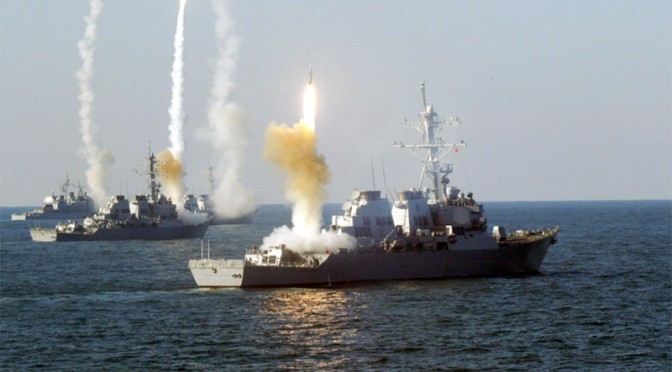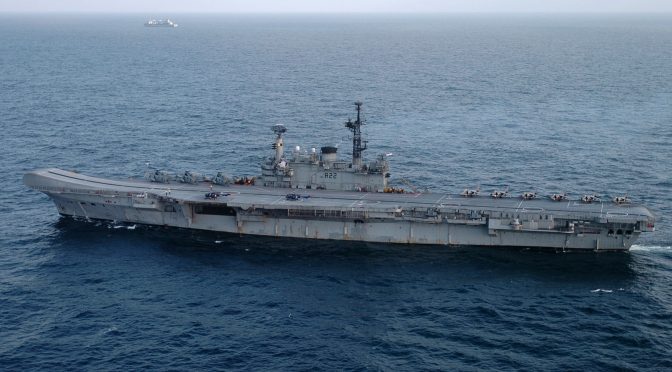Welcome to Part One of the September 2015 Member Round-up, covering the first two weeks of the month. CIMSEC members examined several international maritime security issues, including Russian blue water operations, European maritime security threats, the PLA-N maritime strategy in the Asia-Pacific and aspects of the U.S. military defense procurement program.
The first part of the September Round-up begins with Alex Calvo for The Jamestown Foundation, where he discuses Russia’s naval presence in Spain’s African exclave of Ceuta. Mr. Calvo describes the strategic importance of Ceuta as a launching point for Russian surface fleet operations throughout the Mediterranean Sea region. Additionally, a geopolitical assessment is provided regarding the unique relationship between Spain and Russia in a period of high tensions between Russia and NATO over Ukraine.
Continuing on European maritime security issues, Chuck Hill, for his Coast Guard Blog, discusses the development of Offshore Patrol Vessels (OPV) in France and in the Netherlands. Mr. Hill identifies the development of OPVs in France as a response to the government attempting to increase their enforcement capabilities of EEZ territory. Regarding the Netherlands, Mr. Hill describes the specifications of future OPVs with emphasis on the deployment of ‘hull vane’ technologies to increase OPV mobility, stability and range.
Entering the Asia-Pacific region, Ankit Panda, for The Diplomat, analyzes aspects of innocent passage and the movement of U.S. warships near the newly constructed Chinese islands in the South China Sea. With tensions increasing in the region, Mr. Panda explains that continued cooperation between India and Vietnam could enhance the strategic security relationship between the two countries allowing for a more effective approach to confronting China.
In a separate article, Mr. Panda explains that Vietnam has independently begun to increase its maritime capabilities by approving Coast Guard vessels to deploy major weapon systems. This will allow the Vietnamese CG to be more active in the nation’s maritime security objectives and will significantly increase the effectiveness of EEZ enforcement. Mr. Panda also provided a description of three major Chinese missile systems that pose significant regional and global threats to military adversaries. The Df-16 SRBM, the YJ-18 anti-ship cruise missile and the DF-41 ICBM are components of China’s missile force that greatly contribute to the country’s access denial strategy and global military influence.
Harry Kazianis, for The National Interest, shares an analysis on the U.S. Navy’s plan to modernize the Aegis Combat System’s hardware and software. The technological improvements being added will provide increased effectiveness for the Aegis system to conduct its integrated air and missile defense operations. Also for The National Interest, Mr. Kazianis discusses China’s new DF-21D anti-ship ballistic missile as well as the characteristics of a conflict between China and the U.S. in the South China Sea.
Bryan McGrath for The War on the Rocks, concludes the Round-up with discussing aspects of the U.S. Navy’s procurement strategy. He provides a detailed examination on the number of ships required by the U.S. Navy to meet the current security threats facing the United States as well as to sustain the requirements of the maritime objectives of the navy itself. Mr. McGrath explains that the current and projected size of the U.S. Naval fleet, 273 and 308 respectively, is too small to remain effective in multiple regions. He references the U.S. Navy’s 346-ship fleet from the Clinton-era as an appropriate number for managing the current maritime environment and providing sufficient influence in all U.S. theatres of operation.
Members of CIMSEC were also active elsewhere so far in September:
- Matt Hipple, for the Bring the Heat Podcast, discuses China’s maritime strategy, social media in the military and the concept of distributed lethality. Mr. Hipple also discusses the Warrior Writers exhibit at the U.S. Naval Academy with CIMSEC member and USNA museum Director Claude Berube. A description of the USNA Warrior Writers exhibit can be found here.
- Robert Farley, for The National Interest, discusses the issue the U.S. Air Force faces regarding the development of a Long Range Strike Bomber. Mr. Farley explains that cost overruns represent the most serious threat to the LRS-B project, not advanced SAMs, or Russian or Chinese fighter aircraft. In a second article for The National Interest, Farley discusses the U.S. Navy’s Montana Class battleships and the reason they never entered service during WWII.
- James Stavridis, on his Fletcher School Blog, discusses his interviews with the BBC World News, The Observer and The Telegraph on the topic of the Syrian refugees and the most effective policy response for the U.S. ADM. Stavridis also spoke with NPR regarding the future and usefulness of Guantanamo Bay. Lastly, ADM. Stavridis, for SIGNAL magazine, discusses a biological revolution and the implications it will have on U.S. national security.
- Mira Rapp-Hooper during her podcast for the War on the Rocks discusses U.S. – China relations, the current economic instability in China and Chinese President Xi Jinping’s visit with President Barack Obama in Washington. She also announced that she will be moving from CSIS’s Asia Maritime Transparency Initiative to CNAS as a Senior Fellow in the Asia Pacific Security Program.
- Ankit Panda shares two additional articles for The Diplomat, primarily focusing on China’s foreign policy and aspects of the PLA-N blue water operations. Panda examines trends in North Korea – China relations in the first article, while in the second, he discusses China’s deployment of naval forces to the Bearing Sea region off the coast of Alaska.
- Lauren Dickey, for The Council on Foreign Relations, discusses the modernization of the PLA, noting the development of a U.S.-style joint command system within the Chinese military structure.
- Natalie Sambhi, for bloggingheads Foreign Entanglements, discusses China’s naval modernization and buildup, South China Sea tensions and the implications of the upcoming U.S. presidential election on U.S.- China relations.
At CIMSEC we encourage members to continue writing, either here on the NextWar blog or through other means. You can assist us by emailing your works to me, the Director of Member Publicity, at dmp@cimsec.org to make sure we include them in our next round-up.




